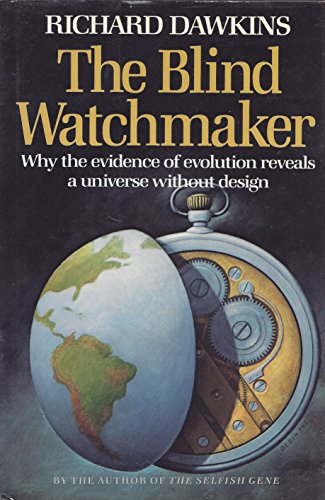Synopsis
The Blind Watchmaker, 1986, by Richard Dawkins. Hardcover with dust jacket, 332 pages, published by W. W. Norton & Company.
Reviews
Oxford zoologist Dawkins (The Selfish Gene, The Extended Phenotype trumpets his thesis in his subtitlealmost guarantee enough that his book will stir controversy. Simply put, he has responded head-on to the argument-by-design most notably made by the 18th century theologian William Paley that the universe, like a watch in its complexity, needed, in effect, a watchmaker to design it. Hewing to Darwin's fundamental (his opponents might say fundamentalist) message, Dawkins sums up: "The theory of evolution by cumulative natural selection is the only theory we know of that is in principle capable of explaining the evolution of organized complexity." Avoiding an arrogant tone despite his up-front convictions, he takes pains to explain carefully, from various sides, why even such esteemed scientists as Niles Eldredge and Stephen Jay Gould, with their "punctuated equilibrium" thesis, are actually gradualists like Darwin himself in their evolutionary views. Dawkins is difficult reading as he describes his computer models of evolutionary possibilities. But, as he draws on his zoological background, emphasizing recent genetic techniques, he can be as engrossing as he is cogent and convincing. His concept of "taming chance" by breaking down the "very improbable into less improbable small components" is daring neo-Darwinism. Line drawings.
Copyright 1986 Reed Business Information, Inc.
Dawkins, author of The Selfish Gene ( LJ 12/1/76), persuasively argues the case for Darwinian evolution. He criticizes the prominent punctuationist school, and takes issue with the views of creationists and others who believe that life arose by design of a deity. Using the evolution of various animals as examples and drawing parallels from improvements in modern technology, Dawkins demonstrates the logic of the selection process and of an incremental evolution whose end products are the highly complex, functional organisms we know today. This provocative work is likely to generate further controversy in the scientific community. Recommended for informed laypersons, undergraduates, and scholars. Joseph Hannibal, Cleveland Museum of Natural History
Copyright 1987 Reed Business Information, Inc.
"About this title" may belong to another edition of this title.
